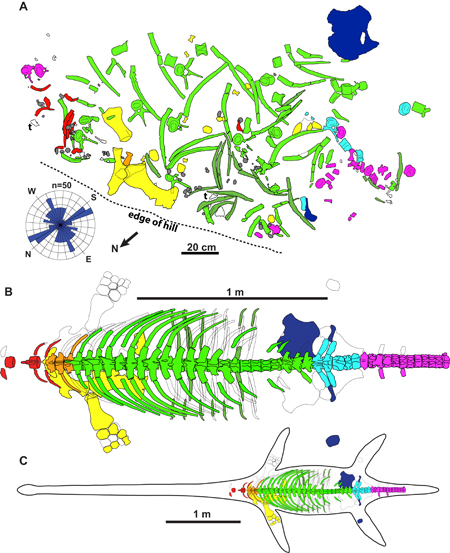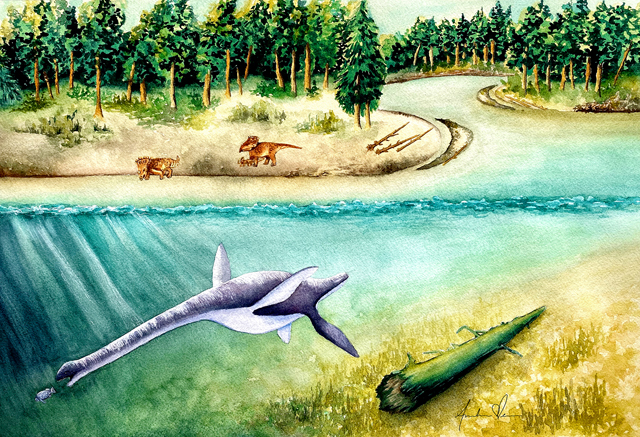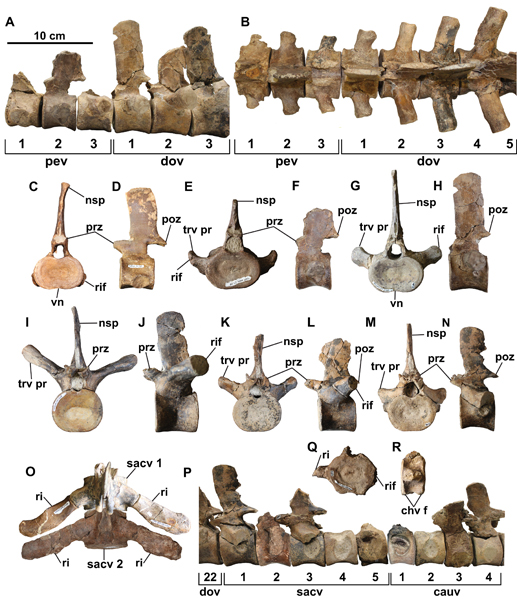Fluvionectes sloanae – Late Cretaceous Freshwater Elasmosaurid
Researchers based in Canada have identified the remains of a Late Cretaceous elasmosaur from fossil remains found in Alberta. Fossils of these large, long-necked plesiosaurs are not unknown from North America, but significantly these fossils were found in rocks laid down in a non-marine environment. This suggests that this elasmosaur named Fluvionectes sloanae, spent at least some of its time in freshwater.
An Artist’s Reconstruction of Fluvionectes sloanae Hunting Fish in a Freshwater Environment
Picture credit: Andrea Elena Noriega
“River Swimmer”
Fossils of plesiosaurs occur throughout the Dinosaur Park Formation but they are generally rare, fragmentary and poorly preserved. As a result, these fossils have attracted little scientific attention although they were first documented by Lawrence Lambe back in 1902.
This specimen is different, it consists of a partial disarticulated skeleton made up of a single tooth, numerous vertebrae, ribs, parts of the pectoral and pelvic girdles and elements from the left forelimb and left hindlimb. The bones and the tooth were collected from a stratum immediately overlying the basal most coal bed of the Lethbridge Coal Zone in the Dinosaur Park Formation with the first material discovered in 1990.
Fluvionectes sloanae
It is the most complete example of an elasmosaurid found to date in the Dinosaur Park Formation and as such, the researchers have been able to formally describe the specimen and assign it a scientific name – Fluvionectes sloanae. The genus name translates as “river swimmer”, a reference to the fact that the fossils come from alluvial deposits believed to have been laid down at least 100 kilometres inland from the Western Interior Seaway. The species name honours Donna Sloan who discovered the holotype, and in recognition of her service to palaeontology, both in the field and as the scientific illustrator at the Royal Tyrrell Museum of Palaeontology (Drumheller, Alberta).
Quarry Map and Skeletal Reconstruction of F. sloanae

Quarry map and skeletal reconstruction of F. sloanae. The fossil material was found scattered over an area of around 2.5 square metres.
Picture credit: Campbell et al (PeerJ)
A Freshwater Predator (Fluvionectes sloanae)
A taxonomic analysis conducted by the scientists which included Dr James Campbell of the University of Calgary and Mark Mitchell, a technician at the Royal Tyrrell Museum of Palaeontology, failed to resolve definitively the exact taxonomic relationship of Fluvionectes within the Elasmosauridae. However, the team were able to conclude that the fossil remains probably represent a young adult. The specimen indicates an animal approximately 5.6 metres long when it died.
Fragmentary fossils of potentially larger elasmosaurids, representing animals around seven metres in length have been found in the Dinosaur Park Formation. Some of these specimens might represent the Fluvionectes genus. The scientists conclude that further study is needed to identify specimens at the genus level.
Views of the Vertebrae Associated with Fluvionectes sloanae
Picture credit: campbell et al (PeerJ)
Everything Dinosaur stocks a wide range of marine reptile models. Models of elasmosaurs, plesiosaurs and mosasaurs are in stock.
To view a selection of marine reptile figures: Wild Safari Prehistoric World Models and Figures.
Did Some Juvenile Elasmosaurs Live in Freshwater?
Intriguingly, the elasmosaurid fossils found in the Dinosaur Park Formation (non-marine deposition), are relatively small when compared to elasmosaurid fossils found in offshore, marine deposits such as the Pierre Shale or Bearpaw formations. Large elasmosaur fossil bones have not been found in the Dinosaur Park Formation. It could be speculated that juvenile elasmosaurs ventured into estuarine environments and freshwater river systems before relocating to marine environments when they reached maturity.
This is not the first example of a marine reptile, normally associated with marine environments been found in freshwater. To read Everything Dinosaur’s 2013 article about the discovery of a freshwater pliosaur in Australia: Freshwater Pliosaur from Cretaceous Australia.
To read our article about a freshwater Mosasaur: Freshwater Mosasaur from a Hungarian Bauxite Mine.
The scientific paper: “A new elasmosaurid (Sauropterygia: Plesiosauria) from the non-marine to paralic Dinosaur Park Formation of southern Alberta, Canada” by James A. Campbell, Mark T. Mitchell, Michael J. Ryan and Jason S. Anderson published in PeerJ.
Visit the Everything Dinosaur website: Everything Dinosaur.








Leave A Comment